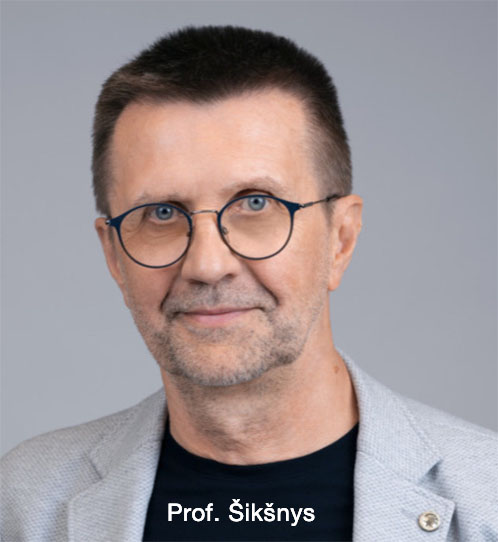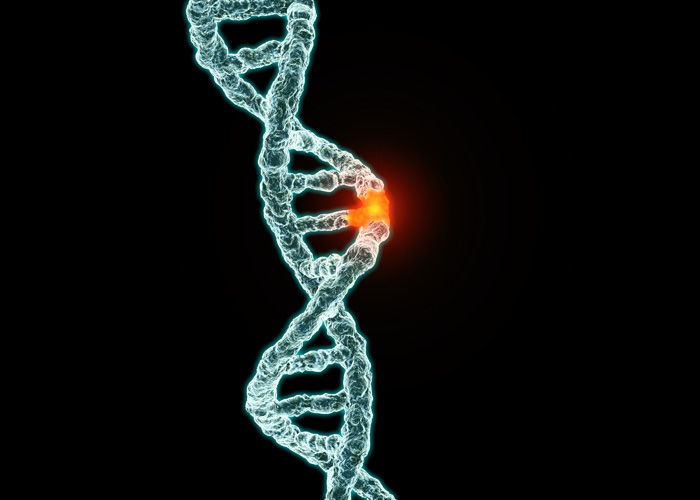On behalf of Manufacturing Chemist, Goda Raibytė-Aleksa spoke with Prof. Šikšnys at his office at the Life Sciences Center of Vilnius University (VU LSC) to find out more.
MC: Tell us, please, how CRISPR-Cas9 technology developed from the beginning?
VS: Understanding how technologies develop is an important and interesting question. People might think that researchers come to the lab, develop technology and the next day it’s already implemented.
In fact, it is a long process that usually starts by looking for answers to very general biological questions aimed at understanding the world and environment around us. CRISPR-Cas9 technology is a nice illustration of this process as it emerged while trying to understand how viruses interact with bacteria.
We all know how viruses affect people, as the COVID-19 pandemic has obviously shown. However, viruses also interact with bacteria in the invisible world with the same conflicts as our own.
Viruses attack bacteria to reproduce and often kill them when viral replication is completed. In other words, if there were no bacteria, there would be no viruses.
To cope with the viral threat, bacteria developed multiple antiviral defence barriers; but, as viruses need to get into bacteria to reproduce, they are constantly trying to overcome these defences.
I sometimes call it an “arms race” in which each side is looking for ways to defend against or defeat the enemy — which forces the enemy to find new weapons — and this happens endlessly. This is how bacteria and viruses coevolve.
This struggle is also important in our everyday life. When we eat yoghurt, we may not often think (unless it’s written on the packaging) that live bacteria were used to make it. During fermentation, the milk is infected with bacteria that can turn it into yoghurt.
If viruses enter this process, the bacteria are often killed and the fermentation fails as the milk is spoiled. This issue is important for the entire dairy industry.
The people who first noticed that CRISPR-Cas9 systems work as bacteria’s defences against viruses worked for companies that produce starter cultures for the dairy industry. By examining the DNA of bacterial cultures, they saw that bits of viral DNA appeared in the bacteria genome.
Researchers then began delving into how it was possible that bacteria have segments of viral DNA. Finally, it was found that there are certain genes close to the areas where the DNA fragments settle and these genes were important both for the incorporation of viral DNA and antiviral defence.
This was the first evidence that the CRISPR system protects bacteria from a virus.
MC: And how did you get interested in CRISPR-Cas9?
VS: We got involved in 2007 when the first article describing CRISPR-Cas systems was published in the journal Science. I got very interested after reading that article.

Its authors suggested that bacteria have a novel antiviral defence system but no one understood how it worked. I was curious to figure it out. Then, we asked the authors of the article to send us cultures of those bacteria, we purified the proteins and began to study them using biochemical methods.
We found that one of the proteins of the CRISPR-Cas systems, called Cas9, acts as a key element of the defence system. It can recognise and destroy the viral DNA.
The protein recognises the virus by using a short RNA molecule that looks like a fingerprint of the invaders' DNA. After recognition, the viral DNA is cut into pieces.
We realised that if we changed the fragment of RNA that recognises the virus, we could direct the Cas9 protein to any location on the DNA. Thus, the idea was born that it could be a programmable tool to cut DNA. We described this in our first article.
Owing to the easy reprogrammability of Cas9, researchers immediately started using it as a tool that enables the targeted modification of genomes, including mammalian cells.
I’d like to end where I started: CRISPR-Cas9 technology came about because we and other researchers were looking for answers to common biological questions. In this case, we wanted to understand how bacteria defend themselves against viruses.
It seems to me that this is how most of the technologies are initiated. It all starts with basic research, followed by applied research and further development of technological developments. If we eliminated at least one link in this chain, nothing good would happen.
MC: As one of the pioneers of the technology, which CRISPR-Cas9 achievements please you the most?
VS: We published the first article about CRISPR-Cas9 in 2012. Now, just 11 years later, the technology is already in the clinic. Most recently, it was announced that the first CRISPR-based therapy for the treatment of inherited diseases just has been registered in the UK.
Of course, 11 years may seem like a very long time; but, in reality, it is a very short period of time. In just 10 years, we have gone from understanding the biological process to clinical therapies.
CRISPR-Cas9 is primarily applied to inherited genetic diseases that result because of changes in the DNA molecule. The therapy I’ve mentioned, which has already been approved in the UK, is intended for the treatment of sickle-cell anaemia and beta-thalassemia.
Until now, these were incurable and life-threatening diseases. Sickle-cell anaemia is a blood disease that develops from a mutation in the haemoglobin gene.
By using CRISPR-Cas9 technology, a pathway is activated in the body that produces normal haemoglobin.
Clinical trials have shown excellent results and many patients have been transfusion-free for a year. Just imagine how their quality of life has improved.
MC: Can you explain in more detail how CRISPR-Cas9 therapy works?
VS: The stem cells responsible for the production of the red blood cells are in our bone marrow. If these cells carry a mutated haemoglobin gene then the red blood cells that originate from these cells will produce a defective haemoglobin molecule that will cause the disease.
Now, researchers can take bone marrow cells, change them in the lab and transplant them back into the human bone marrow. The replaced cells start producing blood cells containing the correct haemoglobin version.
Such therapy is long and complicated, but the result is excellent. Otherwise, a person would not be able to recover from that disease.
MC: Is it possible to cure genetic conditions such as Down syndrome with CRISPR-Cas9?
VS: The reason researchers focused on blood diseases is that some of them, like sickle-cell anaemia, are caused by a single mutation. After the correction of that single mutation, the person will become healthy.
Other diseases, such as Down syndrome, have a genetic basis, but these are complex changes that occur in large numbers in the human genome. It is complicated to change all of them at once. Of course, researchers are thinking about how to do it … but these are questions for the future.
Another reason is that, in the treatment of some blood diseases, cells that are responsible for producing red blood cells, for example, can be removed from the bone marrow, “repaired” in the lab and returned to the human body.
If we wanted to apply the same therapy without removing those cells, we would need other tools.

For example, if we want to use CRISPR-Cas technology to correct DNA errors in other tissues or organs, we need to find ways to “target” that tool to a specific organ. If the bone marrow cells can be removed, you can’t remove the brain or the heart. So, researchers are looking for ways to deliver these tools directly into the body.
MC: Are we talking about targeting specific organs?
VS: Yes. One approach that is being actively explored is based on iRNA vaccine delivery technology, which many of us have already tried. Vaccines contain lipid nanoparticles, inside which an iRNA molecule is inserted encoding a certain protein.
The iRNA serves as the information to synthesise the protein that triggers the reaction, which then gives us protection against the real virus.
Researchers are looking at inserting the iRNA of genetic scissors into lipid particles and inject them into the body. They are currently exploring ways to target them to certain organs.
Lipid particles, like most of the fat molecules, often end their journey in the liver. It is not surprising that CRISPR tools packaged in lipid nanoparticles will soon be used to treat liver diseases.
MC: Will it be possible to take CRISPR-Cas9 into the brain or other cells?
VS: Various delivery vehicles are being examined for this purpose. One of the alternatives is to use viruses as delivery vehicles. There are viruses that are not dangerous to us because we live with them, but they can be reprogrammed so that they will carry DNA that encodes the gene scissors.
These engineered viruses can be specific to certain tissues, such as the heart, brain, etc., and injected directly into the blood or a specific organ. In short, the next step is to do the gene editing in the body — circumventing the need to remove cells for the therapy.
MC: Let’s talk about your research; what are you studying now?
VS: As I’ve said, gene scissors can be inserted into a virus to deliver it to the right tissue or organ. But viruses have their own limitations; some of them are rather small and have a limited cargo capacity, so you can’t put a large DNA molecule inside. It just doesn’t fit! And the CRISPR-Cas9 tool is pretty big.
Now, we’re looking for tools to fit the virus. One of the tools we described in our Nature articles is very compact. It is not part of the CRISPR systems, but comes from other DNA elements, which are called “mobile genetic elements.”
In fact, they are the ancestors of CRISPR systems. We have identified its molecular function and solved the structure. We hope that this compact gene editing tool will help us to circumvent the packaging limit of viruses. And we continue to look for new tools with unique features.
MC: Will a greater public awareness of genetic engineering help to get more funding for research?
VS: Yes, I believe it would. Of course, it’s very important to have direct contact with society. Researchers may not all be very good communicators. They sometimes speak in terms that are too complexly for most people to understand.
In the old days, when many people couldn’t read, there was a category of people who interpreted the Bible. They read the Bible and explained it in a language that people could understand.
I think that’s what Manufacturing Chemist and other outlets are doing: you’re trying to explain to the public what researchers are doing and why it’s important to all of us. After all, the open dialogue with society determines whether the technologies developed by researchers will be acceptable to society or not.
